While the James Webb Space Telescope is already revealing new insights into the deepest recesses of the visible universe, the Hubble Space Telescope is far from obsolete, as a new photo of the Terzan 1 cluster shows.
The photo, released on Oct. 10 by NASA and the European Space Agency (ESA), which jointly run the mission, shows a globular cluster located 22,000 light-years from Earth, revealing a gorgeous palette of different-colored stars in remarkable clarity.
This isn’t the Hubble Space Telescope‘s first photo of the Terzan 1 cluster; NASA released a previous view in 2015. According to an ESA statement, the 2015 photo was taken using Hubble’s Wide Field Planetary Camera 2, which operated until 2009. That instrument had a much lower resolution than the observatory’s current Wide Field Camera 3, which captured the new image and which astronauts installed during the last Hubble servicing mission .
Related: The best Hubble Space Telescope images of all time!
The new photo shows the depth of the globular cluster in far more detail than the previous image, revealing a multitude of red, aging stars bound together by their mutual gravity. Globular clusters are typically a collection of about a hundred thousand stars in a tight, roughly spherical shape. The stars are packed together so tightly that the average distance between any two individual stars is about one light-year, which is roughly one-fourth of the distance between the sun and our nearest neighboring star, Proxima Centauri.
Often, these clusters are home to some of the oldest stars in our galaxy, which appear red in the Hubble image, while the bluer stars in the photo are younger foreground stars that aren’t part of the cluster, although they definitely add some panache to the stellar canvas.
“The ages of the stars in the globular cluster tell us that they were formed during the early stages of galaxy formation,” ESA officials wrote in a 2015 statement about the older photo. “Studying them can also help us to understand how galaxies formed.”
Globular clusters like Terzan 1 are a significant local source of X-rays, ESA noted. “It is likely that these X-rays come from binary star systems that contain a dense neutron star and a normal star,” officials wrote. A neutron star is the super-dense remnant left behind by a sun-like star exploding when it runs out of fuel. “The neutron star drags material from the companion star, causing a burst of X-ray emission.”
Scientists aren’t sure how many stellar-mass or intermediate-mass black holes lurk inside globular clusters like Terzan 1. Since it is impossible to “see” a black hole — they absorb light rather than radiate it — the best way for a telescope to detect them is by observing their gravitational influence on surrounding stars. Unfortunately, this is much more difficult to do in a globular cluster because of the density of stars.
Follow us on Twitter @Spacedotcom (opens in new tab) or on Facebook (opens in new tab).

